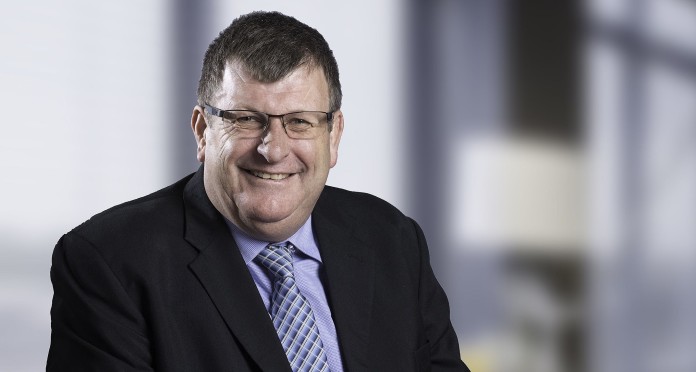
You’ve got to hand it to Harmony’s boss of five years, Peter Steenkamp: he’s made the best of a helpful gold price. In the second half of this year, the company will have a run-rate of 1.8 million ounces, nearly double its annual production in 2016.
To put that in perspective, that’s roughly 55% of total national gold production, assuming it’s at the 101 tons of 2019. While capital has largely fled South African gold, Harmony has carved out a niche in a sector that 40 years ago produced 10 times as much.
“It was quite a tough decision to join Harmony at the time,” said Steenkamp of his decision to leave South African petrochemical group Sasol where he was MD of mining. “But it worked out quite well.”
He was lucky and smart; smart because Steenkamp – who was earlier in his career COO of Harmony – brought an end to the unplanned mining stoppages that had made its performance difficult to predict. And then there was the gold price.
Between 2016 and June, the dollar gold price has increased $700/oz – about 65%; in rand terms it’s more than 100% higher. It gave the firm’s older mines much-needed margin and Steenkamp some valuable breathing space to set about finding new sources of production.
He first thought to buy mines opportunistically in Africa; as it turned out, however, Harmony’s most impactful deal-making was done much closer to home.
End-June represented the pencilled-in date when Harmony was to have bought Mponeng and Mine Waste Solutions from AngloGold, a $300m transaction that adds about 350,000 oz/year in annual output. It mirrors the 2018 deal in which Harmony bought Moab Khotsong, also from AngloGold for $300m.
My first reaction was: ‘I’ve just turned 60 … how do I go through this?
In that respect, Harmony has the large, high-quality orebodies that a former CEO of the firm, Bernard Swanepoel, sought in the merger with Gold Fields in 2002. A bigger test awaits, however.
Wafi-Golpu in Papua New Guinea (PNG) is an enormous greenfields gold/copper project Harmony shares with Newcrest Mining, an Australian firm. The two have been trying to get the project on the road for years, but have been frustrated by a combination of market forces and, more lately, PNG’s volatile political life. A decisive moment in the project’s development will be the grant of a special mining lease (SML) from the PNG government.
“There is disappointment that we took so long to get where we are,” said Steenkamp. “We started with the application in 2016 and we’re in 2020 and we still don’t have an SML … At the moment we are not able to travel to PNG, so we can’t have face-to-face meetings. But I must say, we are very encouraged with the public statements from the prime minister about the project so, hopefully, we should see some good traction.”
This article was first published in the Mining Yearbook 2020 which is available here: https://www.miningmx.com/the-mining-yearbook-2020/
Those meetings may have to wait until countries are able to navigate the COVID-19 pandemic when international travel returns. In the meantime, COVID-19 is presenting challenges closer to home.
At the time of writing, Harmony had spent R70m on kitting out employees with personal protective equipment and putting in place quarantine facilities. Steenkamp acknowledges he suffered trepidation, like the rest of the industry, when the scale of the virus hit home. “My first reaction was: ‘I’ve just turned 60 … how do I go through this?’
“But what was so wonderful about this is the reaction of the team. It’s really strengthened my belief in mining and how we actually deal with things over time.”
Steenkamp estimates Harmony will only get back into its operational groove in August, given the current clip of recovery. It’s taking longer than anticipated to get the firm’s 7,000 migrant employees back into the country. So there will be financial consequences, the strength of the rand gold price notwithstanding.
GOLD HEDGING
One is the impact of the firm’s hedging strategy, which is underwater at the moment. Having to deliver into the contract equal to a fifth of total gold production, at a time when gold production is below capacity, exposes the firm’s revenue.
Its debt reduction drive will also be interrupted. Handily, the Mponeng purchase was done in shares when the firm’s valuation was near record levels. That’s taken unnecessary stress off the balance sheet at a time when funding power is a burning, long-term question.
While Wafi-Golpu hangs in the balance, Harmony’s production replacement will have to come from organic expansion, especially at Moab Khotsong and Mponeng. How is the firm going to balance funding those projects, and still keep its powder dry for Wafi-Golpu?
We’ve always been able to find mining certain areas above infrastructure that can extend the life of mine
“We think we can do it at a bit of a lower cost than was in the original feasibility,” he said of a shaft deepening project at Mponeng that AngloGold priced at $252m. “We haven’t made that decision. We have a nine-year life of mine there and probably need to make that decision in about three years from now.”
He’s got a similar approach to Zaaiplaats, which is Moab’s extension project. What will give Steenkamp comfort is that Harmony has the canny skill of squirrelling out new mining areas that went unnoticed by previous owners, or which hove into view at a higher price.
The extension of Kusasalethu, west of Johannesburg is a case in point. Shortly after joining Harmony, Steenkamp shortened its life to five years from 25. But it’s now got another four years longer than planned, helped by the gold price of course.
“We’ve always been able to find mining certain areas above infrastructure that can extend the life of mine.” That’s why the company keeps on surviving even as others pack up for greener shores.











